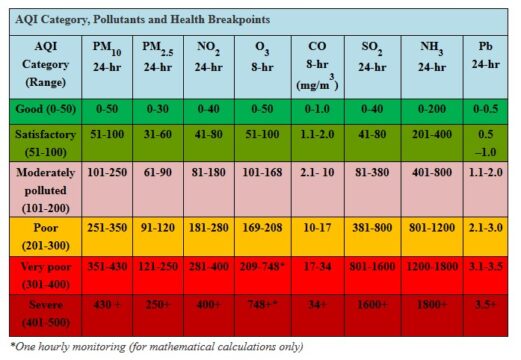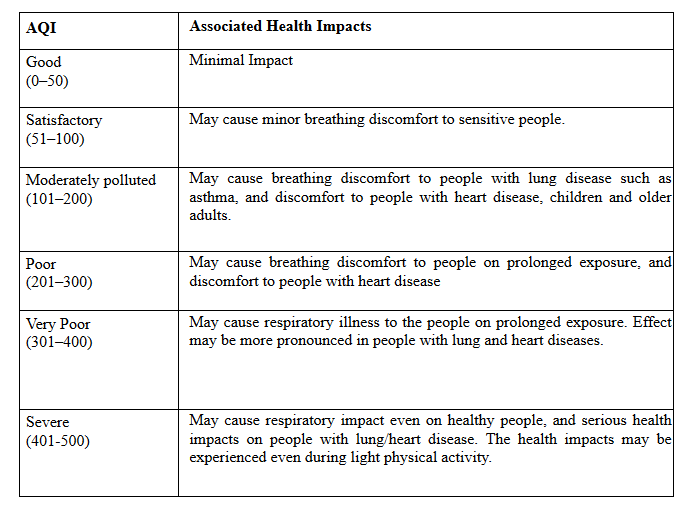Many times, we read the term Air Quality Index or AQI in newspapers, radio or TV and wonder;
“What is AQI and why everyone is talking about it?”
In simple terms, AQI is an index for monitoring & reporting daily air quality.
Awareness of daily pollution levels is important, especially for those who are suffering from certain ailments caused by exposure to air pollution.
The government of any country should communicate and inform their citizens about local and national air pollution problems and the progress of mitigation efforts.
Thus, simple yet effective communication of air quality is very important.
In this article, we will discuss about the interpretation & calculation of the air quality index.
In the end, I will provide various sources and applications which you can use to check the quality of air in your area.
What is Air Quality Index (AQI)?
Air Quality Index (AQI) is a measure of ambient air quality in a standard summarized format.
It tells us how clean or harmful air is.
Owing to its simplicity, the AQI serves as a convenient early warning tool.
This Index provides the weighted values of concentration of principal air pollutants and associated parameters (such as PM10, PM2.5, Ozone, SO2, CO, NO2, visibility, etc.) into a single number or set of numbers for easy interpretation.
AQI represents the level of health risk related to particulate and gaseous air pollution.
Air Quality Index is widely used for air quality monitoring, communication, and decision-making in many countries including India.
Check out this video by IndianExpress
What is the Need for AQI?
Air is vital for all living beings in addition to water and land.
Every day huge volumes of data are being recorded in different areas in order to monitor the air quality.
This whole bunch of data is not providing a clear picture to anyone.
A common person cannot say how good or bad the air is by looking at these figures so how an individual can judge the quality of air?

In order to appraise the community about the potential health effects of the measured ambient air pollution levels an easy to understand information is required.
As a result, a summary index, known as the Air Quality Index (AQI) was introduced due to the initiatives taken by the Environmental Protection Agency (USA) in 1998.
AQI allows the distinction between “good” and “bad” ambient air quality.
Although different countries have standards for the same types of air pollutants the limits may be quite different.
Country specific air quality index may differ in terms of internal compositions.
For example,
Canada – Air Quality Health Index (AQHI)
Singapore – Pollutant Standards Index (PSI)
Malaysia – Air Pollution Index (API)
India – National Air Quality Index (AQI)
What is National Air Quality Index [India]?

The Environment Minister Shri Prakash Javadekar launched the National Air Quality Index (AQI) on 17 October 2014 under the Swachh Bharat Abhiyan.
This index will provide information on air quality in an easily understandable format for the common public.
According to CPCB-
The earlier index was only limited to three indicators but the current measurement index is quite comprehensive by the addition of five additional parameters.
The new AQI will measure the following eight pollutants to judge the quality of air:
- Particulate Matter (PM10) (size less than 10 µm)
- Particulate Matter (PM2.5) (size less than 2.5 µm)
- Nitrogen Dioxide (NO2),
- Sulphur Dioxide (SO2),
- Carbon Monoxide (CO),
- Ozone (O3),
- Ammonia (NH3), and
- Lead (Pb)
| Further Reading: How Electric Vehicles can save your money & environment |
How to Interpret AQI values | Potential Health Impacts
The air quality is classified into six colored bands for easy understanding.
Each band has cut points of concentration with a color code to express the level of severity.

High AQI Value = Higher pollution level = Higher health concern
For example,
An AQI of 50 represents good air quality with little or no potential harm to public health.
AQI values at or below 100 are generally considered as acceptable.
Whereas an AQI value of over 400 signifies hazardous air quality, which can seriously affect the public health.
Always remember,
Whenever air quality index in your locality is showing above 50 then it means that air quality is unhealthy to an extent but for certain sensitive groups of people.
As AQI value further increases then air becomes unhealthier for everyone.
Please refer the below table provided by CPCB-

Air Quality Index Calculation in India
The value for individual pollutants at any monitoring location is calculated using its 24-hourly average concentration value (8-hourly in case of CO and O3).
It is important to note that every time the above eight pollutants may not be monitored.
Overall AQI calculation requires the data for a minimum of three pollutants and out of them either PM2.5 or PM10 is necessary.
Furthermore, a minimum of 16 hours of data is necessary to calculate the sub-index values.
This index can differ at certain locations depending on the time of the day.
AQI will reflect the status of the worst pollutant in that city.
This means that one city can have high reading due to a high concentration of particulate matter whereas in some other city it may be due to SO2.
Out of the eight pollutants, if one pollutant is in “poor” category then the overall air quality index is “Poor” even if the other seven pollutants showing a normal reading.
Who Performs Air Quality Monitoring in India
Central Pollution Control Board (CPCB), State Pollution Control Boards (SPCB), Pollution control committees (PCC), and National Environmental Engineering Research Institute (NEERI) collectively monitor ambient air quality in Indian cities.
These monitoring stations are following the standards & norms of the World Health Organization and verified by CPCB.
Total numbers of Air Quality Monitoring stations installed in India
According to a report by NDTV–
As of January 2019, the network consists of 731 operating stations, covering 312 cities/towns in 29 states and 6 Union Territories of the country as compared to 342 operating stations in 127 cities/towns across the 26 states and 4 Union Territories of the country in 2016.
How to Check Air Quality Index Near Me
We can check the air quality index in various Indian cities using mobile apps, the Internet, or newspaper and media.
Let us discuss each of them in detail:-
Mobile Apps:
Mobile apps are the best way to get real-time data for your city which are available for android as well as iOS.
Some apps are
This is the best app to monitor air pollution.
Central Pollution Control Board (CPCB) developed this app that provides hourly updates about the air quality based on the location you choose.
There is a facility in the app to register complaints with CPCB regarding pollution levels in your area.
Based on real-time air quality data this app provides personalized health recommendations.
You can also compare past data of various locations.
Ministry of Earth Sciences, India has developed a unique app that provides air quality forecasting for Indian Metro Cities.
This is the first-ever app that provides a forecasting system as other apps act as monitoring tools only.
Internet:
You can find the latest values of air quality index on the Internet.
This type of automated system captures data on a continuous basis from various monitoring stations installed in your city.
Advanced web-based systems will provide the AQI values on a real-time basis.
Check out the air quality in real-time – Click here
You can also check the live values provided by CPCB continuous Monitoring stations.
If you want to know the world’s real-time air quality index then you can click here.
Media:
Many Local/National TV channels, radio and newspapers provide air quality reports on a daily basis.
Final Words
Air Pollution is the biggest problem in our country.
You may be aware that there are many cities including Beijing and Paris who declared ‘Pollution emergency’ earlier however, India is not behind them and declared the same in Delhi in November 2019.
In order to ascertain the potential health effects of the measured ambient air pollution levels, you must understand the concept behind air quality monitoring.
There are many apps and resources through which you can keep yourself updated by checking the air quality index in your area.
Just remember, your active participation is the key to solve such problems.
Do you find this article helpful?
Please provide your comments below and share this article to help others.
To join the Save Environment bandwagon consider subscribing bharatgogreen.
References:
- All about effective air quality monitoring
- http://www.indiaenvironmentportal.org.in/files/file/Air%20Quality%20Index.pdf
- National Air Quality Index
- http://www.cpcb.nic.in
- National Air Quality Index (AQI) launched by the Environment Minister AQI is a huge initiative under ‘Swachh Bharat’
- https://www3.epa.gov/airnow/aqi_brochure_02_14.pdf
- https://www.researchgate.net/publication/289707985_Air_quality_index_and_its_significance_in_environmental_health_risk_communication